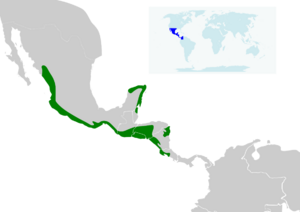Cinnamon hummingbird facts for kids
Quick facts for kids Cinnamon hummingbird |
|
|---|---|
 |
|
| Amazilia rutila rutila Suchitepéquez Department, Guatemala |
|
| Conservation status | |
| Scientific classification | |
| Genus: |
Amazilia
|
| Species: |
rutila
|
 |
|
| Range of A. rutila | |
The cinnamon hummingbird (Amazilia rutila) is a beautiful bird known for its bright, warm colors. It is a type of hummingbird found in Central America. You can spot these tiny birds from northwestern Mexico all the way down to Costa Rica. They are part of a group of hummingbirds often called "emeralds."
Contents
What's in a Name?
Scientists give every animal a special two-part name. This helps everyone know exactly which animal they are talking about. The cinnamon hummingbird's scientific name is Amazilia rutila.
How it Got its Name
A French scientist named René Lesson first described this hummingbird in 1842. He found it near Acapulco, Mexico. Later, another French scientist, Adolphe Delattre, gave it the name Ornismya rutila.
The hummingbird is now placed in the genus Amazilia. This name comes from an Inca heroine in an old novel. The second part of its name, rutila, is a Latin word. It means "golden," "red," or "auburn," which perfectly describes the bird's beautiful colors!
Different Types of Cinnamon Hummingbirds
There are four slightly different types of cinnamon hummingbirds. Scientists call these "subspecies." They are:
- Amazilia rutila diluta
- Amazilia rutila graysoni
- Amazilia rutila rutila (this is the main type)
- Amazilia rutila corallirostris
These subspecies look very similar but might have small differences in color or size.
What Does it Look Like?
The cinnamon hummingbird is a small bird. It is about 9.5 to 11.5 centimeters (3.7 to 4.5 inches) long. It weighs about 5 to 5.5 grams (0.18 to 0.19 ounces). That's about the weight of two pennies!
Colors and Markings
The top part of its body is a shiny, metallic bronze-green. Its belly and chest are a lovely cinnamon or reddish-brown color. This color is lighter on its chin and throat.
Its tail feathers are a deep reddish-brown. The tips of these feathers have a dark, metallic bronze color. Its wings are a dark brownish-gray.
Beak and Young Birds
Male cinnamon hummingbirds have a red beak with a black tip. Females usually have a mostly black beak with some red at the bottom.
Young cinnamon hummingbirds look a lot like the adults. But they have reddish-brown edges on their face, head, and back feathers. Their beaks are all black.
Its Song and Calls
This hummingbird has a varied song. It sounds like high, thin, and slightly squeaky chips. You might hear sounds like "si ch chi-chit" or "tsi si si-si-sit."
Its call is a short, buzzy sound. It can also make a sharp "chik" sound.
Where Does it Live?
The cinnamon hummingbird lives in a wide area. It stays in the same place all year round. You can find it in different parts of Mexico and Central America.
Specific Locations
- The diluta subspecies lives in northwestern Mexico.
- The graysoni subspecies lives on Isla María Madre, an island off western Mexico.
- The rutila subspecies is found from western Mexico down through El Salvador, Honduras, and Nicaragua. It also lives in northwestern Costa Rica.
- The corallirostris subspecies lives from Chiapas in Mexico south to El Salvador.
Favorite Places to Live
These hummingbirds like to live in forests. They prefer forests where trees lose their leaves in certain seasons. They can be found from sea level up to about 1,600 meters (5,200 feet) high.
How Does it Behave?
Finding Food
The cinnamon hummingbird usually looks for food in the lower and middle parts of trees. But it will also visit taller flowering trees. It mainly drinks nectar from many different kinds of flowers. It also eats small insects.
This bird is very protective of its feeding spots. It will chase away other hummingbirds, bees, and butterflies that try to get its food.
Building a Nest
The breeding season for these birds happens at different times depending on where they live. They build their nests on horizontal branches.
The nest is shaped like a cup. It is made from soft plant material and spider webs. Some nests have a small platform of wood pieces under the cup. The cup itself is often made of soft fibers from kapok seeds. Grass, small bits of wood, and lichens are used on the outside of the nest.
Female hummingbirds usually lay two eggs. Not much more is known about their nesting habits.
Is it in Danger?
The IUCN (International Union for Conservation of Nature) has looked at the cinnamon hummingbird. They have decided it is a species of "Least Concern." This means it is not currently in danger of disappearing.
It lives in a very large area. Scientists believe there are at least 500,000 adult birds. Their numbers seem to be stable. The only real threat to them is when their habitat is destroyed in certain areas.


